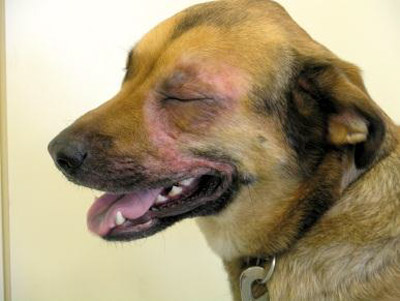Pet Atopic Dermatitis Fact Sheet

Pet Atopic Dermatitis Fact Sheet
While we all know dogs love a good scratch behind the ears, there is nothing worse than watching your dog scratch, lick, chew and rub at a patch of skin. Our usual immediate concern is fleas. But what if it wasn't? What if it was something more serious? As much as they bark and give puppy eyes, dogs can't tell you what's wrong. Instead, they continue to scratch away, becoming irritable and depressed whilst suffering.
Results from the 2012 Novartis Animal Health Pet Allergy Worldwide Survey (PAWS) revealed almost 1 in 5 dogs suffer allergies. But of more concern, the survey found:
44% of pet owners confessed they didn't know that their dog could suffer from allergies, and
A further 43% admitted they wouldn't even know how to tell if their pet was suffering from an allergy.
Many dog owners are shocked when they find out their dog has an allergy. It's easy to think that only humans are affected by allergies, but animals can be just as affected by food, pollen and other household allergies.
Sometimes dog allergies express themselves in the form of a skin condition called atopic dermatitis, also known as atopy, something akin to eczema in humans. Dogs will develop dry itchy skin and then scratch away for as long as they are exposed to the allergen or until they receive treatment. The secondary symptoms of atopic dermatitis can also include hair loss, skin lesions and infections. Due to the constant itchy skin and scratching, dogs suffering atopic dermatitis are regularly unhappy, uncomfortable and depressed.
Up to 10% of dogs suffer from atopic dermatitis. While it is more common in small dogs, dogs of all sizes can be affected. It usually starts appearing between the ages of one to three years of age, but can start at any age. Atopic dermatitis usually appears in areas around:
Ears and face
Paws and feet
Belly
Atopic dermatitis is caused by a hypersensitivity to environmental allergens like pollen, dust mites and mould. Unfortunately, just like hay fever in humans, it is a life-long condition and cannot be -cured'. This is why, just like human eczema, it is important to identify allergy triggers and learn how to manage the condition. Until this condition is identified and diagnosed, it can be quite a confusing and frustrating time for dog owners.
'Atopic dermatitis can be a complex allergy to treat, and once present, it is usually lifelong, so developing an effective long-term treatment plan is of vital importance. Working out a control and treatment plan for allergies including atopic dermatitis with your vet will help bring great relief to both you and your dog" says veterinary dermatologist Dr Linda Vogelnest.
'Dog owners can undertake a number of activities in the home to help reduce their dog's exposure to possible allergen sources and to manage their dog's condition," said Bondi Vet Dr Lisa Chimes, 'At home you can:
Regularly shampoo your dog to help remove possible allergens from their coat
Feed your dog quality dog food, rich in essential fats and nutrients
Wash your dog's bedding and other related soft furnishings regularly
Vacuum regularly
'But most of all, it is really important for dog owners whose dogs are constantly scratching to go talk to their vet. Your vet will be able to identify any allergic conditions present and help provide both short and long term relief and treatment."
Summary of results from the Novartis Animal Health 2012 Pet Allergy Worldwide Survey (PAWS)
44% of pet owners admitted they didn't realise their pets can suffer from allergies just like humans
43% of pet owners admitted they wouldn't know how to tell if their pet was suffering from an allergy
Fewer than 1 in 3 pet owners were aware of common pet skin allergy diseases, such as atopic dermatitis in dogs
Almost 1 in 5 (18%) dogs suffer from some sort of allergy, with up to 10% of dogs suffering from atopic dermatitis
70% of pet owners admitted they know little or nothing about the treatment options available for pet allergies
80% of pet owners would like to know more about how to recognise and treat pet allergies
More information from the 2012 Novartis Animal Health PAWS Survey can be found at www.itchfreepet.com
 Scratching the right itch: Global PAWS report shows majority of pets owners are unaware of their pets' suffering during allergy season
Scratching the right itch: Global PAWS report shows majority of pets owners are unaware of their pets' suffering during allergy season
Cats and dogs can be affected by the same seasonal allergies as humans, but 44% of owners do not realise pets can also suffer from allergies
More than 1,250 owners in six countries participated in the Pet Allergy Worldwide Survey (PAWS), 46% of whom suffer from allergies, increasing sympathy for their pet's unexpressed discomfort
80% of owners want to find out more about pet allergies; itchfreepet.com offers simple one-minute test to help identify cats and dogs that may be suffering from allergies
With allergy season in full bloom, Novartis Animal Health (NAH) today announced findings from the Pet Allergy Worldwide Survey (PAWS) report, which revealed that nearly half (44%) of pet owners are not aware that their cats and dogs can suffer from allergies, just like humans. In addition, 51% of pet owners did not realise that their pets' allergies are more likely to manifest during the human allergy season, a time of year when pollen and other allergens in the environment can cause distress and irritation for human and animal allergy sufferers alike. Although pet allergies can be present year-round, the spring allergy season can particularly affect allergic pets with agonising symptoms such as constant itching, scratching and licking, and resulting skin inflammation and irritation.
'The Pet Allergy Worldwide Survey results highlight that pets can be affected by the same seasonal allergens, such as pollen, as people," said Dr. Stephen Shaw, a veterinary dermatologist (BVetMed, PhD, DVD MRCVS). 'It's vital for owners to recognise the importance of the most common signs of pet allergy, including scratching more than usual, licking the same area excessively, hair loss and skin rash. Through increased awareness, the owner's vet can go on to correctly diagnose the cause, reduce the pet's suffering, relieve itchiness and skin lesions as efficiently and safely as possible, and improve a pet's quality of life."
The survey, conducted with more than 1,250 pet owners in France, Germany, Italy, Spain, the UK and US, revealed that of the pet owners interviewed, 46% suffer from an allergy themselves, the most common being hay fever. Most of those who have allergies felt more empathy and understanding towards allergic pets as a result. 'I only suffer (from allergies) for 6-8 weeks a year," said one survey participant. 'Constant itching all year long must be very distressing for my dog." Another pet owner said, 'Hay fever really impacts my quality of life. I would hate for my cat to go through the same experience."
Eighty percent of pet owners surveyed said they would like to know more about how to recognise and treat pet allergies. However, 43% admitted that they wouldn't know how to tell if their animal was suffering from an allergy, and fewer than one in three pet owners were aware of one of the most common canine and feline allergic skin diseases: atopic dermatitis in dogs and allergic dermatitis in cats. To help, Novartis Animal Health working together with Dr. Claude Favrot, a board-certified veterinary dermatologist (PhD, Dip ECVD) at the University of Zurich in Switzerland, developed one-minute online tests to help identify cats and dogs that may be suffering from allergies. Available on itchfreepet.com, the tests based on Dr. Favrot's criteria offer pet owners an opportunity to discuss the findings with their veterinarian.
'People with allergies know how miserable they can feel in springtime," said George Gunn, Division Head of Novartis Animal Health. 'By raising awareness of pet allergies and providing a quick and easy online tool, we hope to help owners recognise the signs of allergic conditions so they can work with their veterinarian to bring year-round relief to their animal companions."
It's not surprising that owners want to do as much as possible to help their pets since 71% of pet owners consider their pet as part of the family. 'My cats and dogs are like children," said one survey participant. 'Whatever happens to them makes me suffer."
Novartis Animal Health conducted the survey to investigate pet owners' awareness of canine or feline allergies. The survey was conducted online and took place between February 15 and 22, 2012. Pet owners from the following countries were surveyed: France, Germany, Italy, Spain, the UK and US. Within each category, approximately half were cat owners and half were dog owners. A total of 1,269 cat and dog owners completed the survey; approximately half had a pet with a diagnosed allergy (618) and the other half (651) had pets who have not been diagnosed with an allergy but may have signs of an allergy. This provided an appropriate number of individuals within each category to give unbiased results.
About canine and feline allergies
Atopic dermatitis is one of the most common allergic skin diseases in dogs, and is estimated to affect 10 to 15 percent of dogs. It is caused by hypersensitivity to environmental allergens such as house dust mites, pollen and mold spores, which stimulate an exaggerated immune response in affected animals and can lead to recurrent itching, scratching and licking and resulting in skin irritation or lesions. This disease is chronic, recurrent and requires lifelong management.
Allergic dermatitis is among the top ten reasons that pet owners take their cat to the veterinarian. It is also caused by hypersensitivity to environmental allergens such as house dust mites, pollen and mold spores. Cats with allergic dermatitis are itchy but, unlike dogs, it can sometimes be more difficult to identify if a cat is itching. Pruritus (itching) often manifests in cats as frequent grooming/licking, chewing and sometimes scratching. However, cats can be secretive and find a quiet place to lick and groom making it more difficult for pet owners to recognise the condition.
Novartis Animal Health researches, develops and commercialises leading animal treatments that meet the needs of pet owners, farmers and veterinarians. Headquartered in Basel, Switzerland and present in nearly 40 countries, Novartis Animal Health employs approximately 2,900 people worldwide. For more information, please visit www.ah.novartis.com
Novartis provides innovative healthcare solutions that address the evolving needs of patients and societies. Headquartered in Basel, Switzerland, Novartis offers a diversified portfolio to best meet these needs: innovative medicines, eye care, cost-saving generic pharmaceuticals, preventive vaccines and diagnostic tools, over-the-counter and animal health products. Novartis is the only global company with leading positions in these areas. In 2011, the Group's continuing operations achieved net sales of USD 58.6 billion, while approximately USD 9.6 billion (USD 9.2 billion excluding impairment and amortisation charges) was invested in R&D throughout the Group. Novartis Group companies employ approximately 124,000 full-time-equivalent associates and operate in more than 140 countries around the world. For more information on atopic dermatitis in dogs and how to manage this condition, visit www.itchfreepet.com
Results from the 2012 Novartis Animal Health Pet Allergy Worldwide Survey (PAWS) revealed almost 1 in 5 dogs suffer allergies. But of more concern, the survey found:
44% of pet owners confessed they didn't know that their dog could suffer from allergies, and
A further 43% admitted they wouldn't even know how to tell if their pet was suffering from an allergy.
Many dog owners are shocked when they find out their dog has an allergy. It's easy to think that only humans are affected by allergies, but animals can be just as affected by food, pollen and other household allergies.
Sometimes dog allergies express themselves in the form of a skin condition called atopic dermatitis, also known as atopy, something akin to eczema in humans. Dogs will develop dry itchy skin and then scratch away for as long as they are exposed to the allergen or until they receive treatment. The secondary symptoms of atopic dermatitis can also include hair loss, skin lesions and infections. Due to the constant itchy skin and scratching, dogs suffering atopic dermatitis are regularly unhappy, uncomfortable and depressed.
Up to 10% of dogs suffer from atopic dermatitis. While it is more common in small dogs, dogs of all sizes can be affected. It usually starts appearing between the ages of one to three years of age, but can start at any age. Atopic dermatitis usually appears in areas around:
Ears and face
Paws and feet
Belly
Atopic dermatitis is caused by a hypersensitivity to environmental allergens like pollen, dust mites and mould. Unfortunately, just like hay fever in humans, it is a life-long condition and cannot be -cured'. This is why, just like human eczema, it is important to identify allergy triggers and learn how to manage the condition. Until this condition is identified and diagnosed, it can be quite a confusing and frustrating time for dog owners.
'Atopic dermatitis can be a complex allergy to treat, and once present, it is usually lifelong, so developing an effective long-term treatment plan is of vital importance. Working out a control and treatment plan for allergies including atopic dermatitis with your vet will help bring great relief to both you and your dog" says veterinary dermatologist Dr Linda Vogelnest.
'Dog owners can undertake a number of activities in the home to help reduce their dog's exposure to possible allergen sources and to manage their dog's condition," said Bondi Vet Dr Lisa Chimes, 'At home you can:
Regularly shampoo your dog to help remove possible allergens from their coat
Feed your dog quality dog food, rich in essential fats and nutrients
Wash your dog's bedding and other related soft furnishings regularly
Vacuum regularly
'But most of all, it is really important for dog owners whose dogs are constantly scratching to go talk to their vet. Your vet will be able to identify any allergic conditions present and help provide both short and long term relief and treatment."
Summary of results from the Novartis Animal Health 2012 Pet Allergy Worldwide Survey (PAWS)
44% of pet owners admitted they didn't realise their pets can suffer from allergies just like humans
43% of pet owners admitted they wouldn't know how to tell if their pet was suffering from an allergy
Fewer than 1 in 3 pet owners were aware of common pet skin allergy diseases, such as atopic dermatitis in dogs
Almost 1 in 5 (18%) dogs suffer from some sort of allergy, with up to 10% of dogs suffering from atopic dermatitis
70% of pet owners admitted they know little or nothing about the treatment options available for pet allergies
80% of pet owners would like to know more about how to recognise and treat pet allergies
More information from the 2012 Novartis Animal Health PAWS Survey can be found at www.itchfreepet.com
 Scratching the right itch: Global PAWS report shows majority of pets owners are unaware of their pets' suffering during allergy season
Scratching the right itch: Global PAWS report shows majority of pets owners are unaware of their pets' suffering during allergy season Cats and dogs can be affected by the same seasonal allergies as humans, but 44% of owners do not realise pets can also suffer from allergies
More than 1,250 owners in six countries participated in the Pet Allergy Worldwide Survey (PAWS), 46% of whom suffer from allergies, increasing sympathy for their pet's unexpressed discomfort
80% of owners want to find out more about pet allergies; itchfreepet.com offers simple one-minute test to help identify cats and dogs that may be suffering from allergies
With allergy season in full bloom, Novartis Animal Health (NAH) today announced findings from the Pet Allergy Worldwide Survey (PAWS) report, which revealed that nearly half (44%) of pet owners are not aware that their cats and dogs can suffer from allergies, just like humans. In addition, 51% of pet owners did not realise that their pets' allergies are more likely to manifest during the human allergy season, a time of year when pollen and other allergens in the environment can cause distress and irritation for human and animal allergy sufferers alike. Although pet allergies can be present year-round, the spring allergy season can particularly affect allergic pets with agonising symptoms such as constant itching, scratching and licking, and resulting skin inflammation and irritation.
'The Pet Allergy Worldwide Survey results highlight that pets can be affected by the same seasonal allergens, such as pollen, as people," said Dr. Stephen Shaw, a veterinary dermatologist (BVetMed, PhD, DVD MRCVS). 'It's vital for owners to recognise the importance of the most common signs of pet allergy, including scratching more than usual, licking the same area excessively, hair loss and skin rash. Through increased awareness, the owner's vet can go on to correctly diagnose the cause, reduce the pet's suffering, relieve itchiness and skin lesions as efficiently and safely as possible, and improve a pet's quality of life."
The survey, conducted with more than 1,250 pet owners in France, Germany, Italy, Spain, the UK and US, revealed that of the pet owners interviewed, 46% suffer from an allergy themselves, the most common being hay fever. Most of those who have allergies felt more empathy and understanding towards allergic pets as a result. 'I only suffer (from allergies) for 6-8 weeks a year," said one survey participant. 'Constant itching all year long must be very distressing for my dog." Another pet owner said, 'Hay fever really impacts my quality of life. I would hate for my cat to go through the same experience."
Eighty percent of pet owners surveyed said they would like to know more about how to recognise and treat pet allergies. However, 43% admitted that they wouldn't know how to tell if their animal was suffering from an allergy, and fewer than one in three pet owners were aware of one of the most common canine and feline allergic skin diseases: atopic dermatitis in dogs and allergic dermatitis in cats. To help, Novartis Animal Health working together with Dr. Claude Favrot, a board-certified veterinary dermatologist (PhD, Dip ECVD) at the University of Zurich in Switzerland, developed one-minute online tests to help identify cats and dogs that may be suffering from allergies. Available on itchfreepet.com, the tests based on Dr. Favrot's criteria offer pet owners an opportunity to discuss the findings with their veterinarian.
'People with allergies know how miserable they can feel in springtime," said George Gunn, Division Head of Novartis Animal Health. 'By raising awareness of pet allergies and providing a quick and easy online tool, we hope to help owners recognise the signs of allergic conditions so they can work with their veterinarian to bring year-round relief to their animal companions."
It's not surprising that owners want to do as much as possible to help their pets since 71% of pet owners consider their pet as part of the family. 'My cats and dogs are like children," said one survey participant. 'Whatever happens to them makes me suffer."
Novartis Animal Health conducted the survey to investigate pet owners' awareness of canine or feline allergies. The survey was conducted online and took place between February 15 and 22, 2012. Pet owners from the following countries were surveyed: France, Germany, Italy, Spain, the UK and US. Within each category, approximately half were cat owners and half were dog owners. A total of 1,269 cat and dog owners completed the survey; approximately half had a pet with a diagnosed allergy (618) and the other half (651) had pets who have not been diagnosed with an allergy but may have signs of an allergy. This provided an appropriate number of individuals within each category to give unbiased results.
About canine and feline allergies
Atopic dermatitis is one of the most common allergic skin diseases in dogs, and is estimated to affect 10 to 15 percent of dogs. It is caused by hypersensitivity to environmental allergens such as house dust mites, pollen and mold spores, which stimulate an exaggerated immune response in affected animals and can lead to recurrent itching, scratching and licking and resulting in skin irritation or lesions. This disease is chronic, recurrent and requires lifelong management.
Allergic dermatitis is among the top ten reasons that pet owners take their cat to the veterinarian. It is also caused by hypersensitivity to environmental allergens such as house dust mites, pollen and mold spores. Cats with allergic dermatitis are itchy but, unlike dogs, it can sometimes be more difficult to identify if a cat is itching. Pruritus (itching) often manifests in cats as frequent grooming/licking, chewing and sometimes scratching. However, cats can be secretive and find a quiet place to lick and groom making it more difficult for pet owners to recognise the condition.
Novartis Animal Health researches, develops and commercialises leading animal treatments that meet the needs of pet owners, farmers and veterinarians. Headquartered in Basel, Switzerland and present in nearly 40 countries, Novartis Animal Health employs approximately 2,900 people worldwide. For more information, please visit www.ah.novartis.com
Novartis provides innovative healthcare solutions that address the evolving needs of patients and societies. Headquartered in Basel, Switzerland, Novartis offers a diversified portfolio to best meet these needs: innovative medicines, eye care, cost-saving generic pharmaceuticals, preventive vaccines and diagnostic tools, over-the-counter and animal health products. Novartis is the only global company with leading positions in these areas. In 2011, the Group's continuing operations achieved net sales of USD 58.6 billion, while approximately USD 9.6 billion (USD 9.2 billion excluding impairment and amortisation charges) was invested in R&D throughout the Group. Novartis Group companies employ approximately 124,000 full-time-equivalent associates and operate in more than 140 countries around the world. For more information on atopic dermatitis in dogs and how to manage this condition, visit www.itchfreepet.com
MORE





